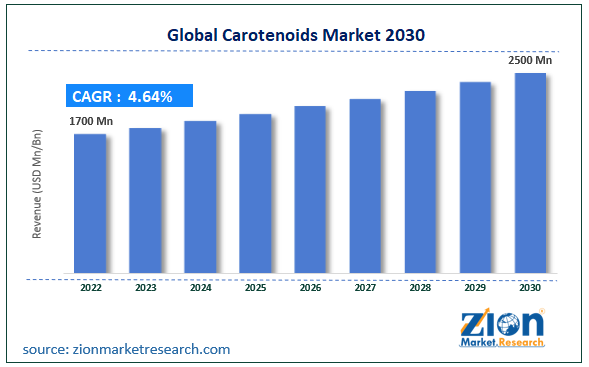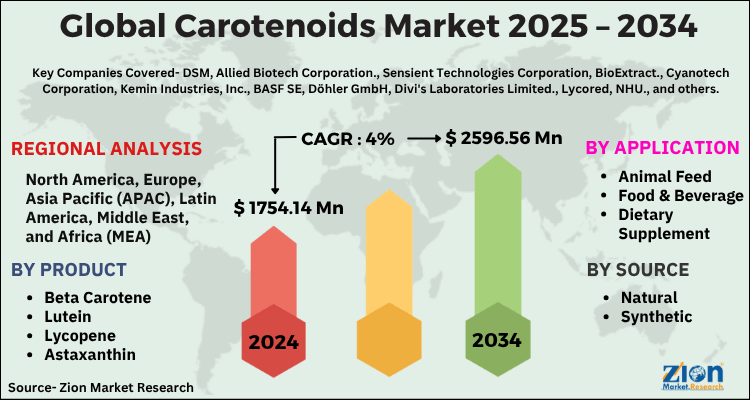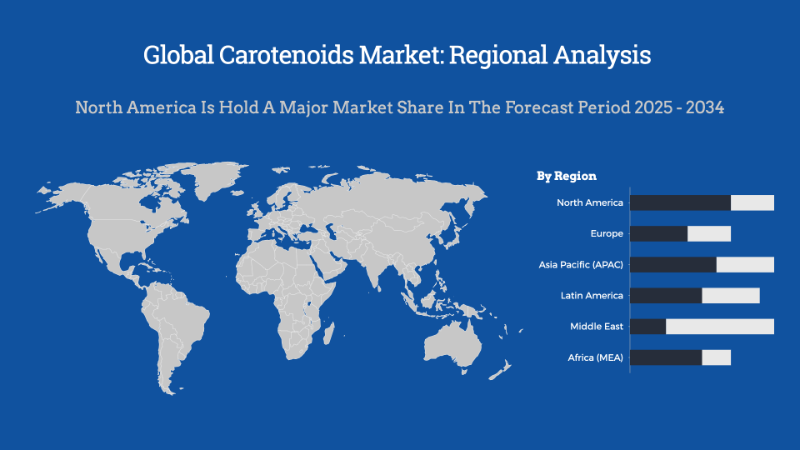Global Carotenoids Market Size, Share, Growth Analysis Report - Forecast 2034

Carotenoids Market By Product (Beta Carotene, Lutein, Lycopene, Astaxanthin, Zeaxanthin, Canthaxanthin, Others), By Application (Food, Supplements, Feed, Pharmaceuticals, Cosmetics), By Source (Natural, Synthetic), and By Region: Global and Regional Industry Overview, Market Intelligence, Comprehensive Analysis, Historical Data, and Forecasts 2025 - 2034
| Market Size in 2024 | Market Forecast in 2034 | CAGR (in %) | Base Year |
|---|---|---|---|
| USD 1754.14 Million | USD 2596.56 Million | 4% | 2024 |
Global Carotenoids Market: Industry Perspective
The global carotenoids market size was worth around USD 1754.14 Million in 2024 and is predicted to grow to around USD 2596.56 Million by 2034 with a compound annual growth rate (CAGR) of roughly 4% between 2025 and 2034. The report analyzes the global carotenoids market's drivers, restraints/challenges, and the effect they have on the demands during the projection period. In addition, the report explores emerging opportunities in the carotenoids industry.
Global Carotenoids Market: Overview
Carotenoids are bioactive agents, which are used in dietary supplement manufacturing & cosmetic formulations. In addition, carotenoids are one of the most important classes of pigments, derived from both synthetic & natural sources. Carotenoids are lipid-soluble C-40 tetraterpenoids. Most of the carotenoids are derived from a C-40 (carbon-40) polyene chain, which is considered the backbone of the molecule. Specifically, the usage of beta-carotene, astaxanthin, lycopene, zeaxanthin, lutein, and canthaxanthin has been increasing for pharmaceutical & nutraceutical applications in recent years.
Dietary carotenoids are used for the prevention of different diseases such as cardiovascular disease, cancers, and eye disease, among others. Various manufacturing firms are investing to expand their production capacity to produce Carotenoids. For instance, in January 2024, Lycored announced a processing facility in Branchburg, New Jersey, United States for its carotenoids, vitamins, and other related products. In addition, rising demand trends in the nutraceutical & food & beverage industry are supporting the carotenoids industry’s growth.
Global Carotenoids Market: Growth Drivers
Rising demand trends in the nutraceutical & food & beverage industry to drive market growth during the forecast period.
The global carotenoids market is projected to grow owing to the increasing demand trends in the nutraceutical & food & beverage industry. Carotenoids are used in nutritional supplement products. Various carotenoids such as zeaxanthin & lutein are widely used for bone health nutraceutical products. Lycopene is used as a nutritional supplement in the treatment of cardiovascular diseases. Lycopene can enhance antioxidant properties, and reduce oxidative stress & cholesterol oxidation. In addition, various carotenoids are used as natural pigments or as colorants in food & beverage products. These pigments are used in the production of bakery & confectionery products, snacks, dairy items, and other food products. Carotenoids such as carotenes, etc. are approved food additives by different regulatory bodies such as the European Commission. BASF SE & DSM are among the key manufacturers of carotenoids for food & beverage applications.
Some of the key firms engaged in nutraceutical manufacturing are Nestlé S.A., General Mills, Inc., Kellogg Company, Herbalife International of America, Inc., and PepsiCo, Inc., among others. In Europe, the nutraceuticals industry is growing at a significant rate in Germany, France, Italy, and the United Kingdom, among others.
In the United States, the domestic nutraceutical manufacturing industry is flourishing, owing to the rising concerns for the health of children & elderly populations, increasing awareness about immune health, and others.
Restraints:
High cost of natural carotenoids to restrict market expansion
Natural carotenoids are costly compared to their synthetic counterparts. The key factor related to the high cost of natural carotenoids is its complicated production processes. Moreover, carotenoids such as astaxanthin & lutein, which are available in different fruits, flowers, and microorganisms, also have high economic value. Moreover, the limited availability of high-content & high productivity sources of natural carotenoids is further increasing the cost of the end products. According to NovoNutrients, a manufacturer of carotenoids, pure natural carotenoids such as natural astaxanthin are valued at over USD 7,000 per kilogram. However, synthetic astaxanthin costs around USD 2,000 per kilogram. All such factors limit the carotenoids industry’s growth.
Opportunities:
Increasing R&D & technological advancement in the carotenoid industry to provide growth opportunities
Various manufacturing firms are investing heavily in R&D & technology development for the production & application of carotenoids in different sectors. Recently, researchers from Peter the Great St. Petersburg Polytechnic University based in Russia found microalgae biomass with a high content of carotenoid pigments. The obtained carotenoid pigments can be used in the food industry. Further, researchers are working on the development of economical & high-end biotechnologically produced carotenoids. Considering its high antioxidant characteristics, natural microbial carotenoids have been proposed as alternatives to synthetic carotenoids for pigment application.
In March 2024, NovoNutrients, a manufacturer of carotenoids, announced an innovation in carotenoid production technology. The company said that its general carbon capture process upcycles around 2 tons of carbon dioxide (CO2) for each ton of protein-rich ingredient production. The company’s biomanufacturing platform provides advantages of scalability, cost savings, and sustainability, compared to conventional manufacturing. By utilizing carbon dioxide & renewable energy through gas fermentation, the company is scaling up its carotenoid production to acquire a significant market share in the coming years.
Challenges:
Associated side-effects of Carotenoid to challenge market cap growth
Various carotenoids can cause low to severe side effects, after consumption. Some of the key side effects of high doses of beta-carotene are joint pain, skin discoloration, and others. Beta-carotene supplements can interact with different medications such as Statins, Orlistat, Cholestyramine, and Colestipol, among others. However, correct dosage & right product selection can avoid these side effects of carotenoids.
The Regional, this segment includes the current and forecast demand for North America, Europe, Asia Pacific, Latin America,and the Middle East and Africa.
Key Insights
- As per the analysis shared by our research analyst, the global carotenoids market is estimated to grow annually at a CAGR of around 4% over the forecast period (2025-2034).
- Regarding revenue, the global carotenoids market size was valued at around USD 1754.14 Million in 2024 and is projected to reach USD 2596.56 Million by 2034.
- The carotenoids market is projected to grow at a significant rate due to increasing consumer awareness of their health benefits, rising demand for natural food colorants and clean-label products, expanding applications in dietary supplements, animal feed, and cosmetics, and continuous advancements in extraction and production .
- Based on Product, the Beta Carotene segment is expected to lead the global market.
- On the basis of Application, the Food segment is growing at a high rate and will continue to dominate the global market.
- Based on the Source, the Natural segment is projected to swipe the largest market share.
- Based on region, North America is predicted to dominate the global market during the forecast period.
Global Carotenoids Market: Report Scope
| Report Attributes | Report Details |
|---|---|
| Report Name | Carotenoids Market |
| Market Size in 2024 | USD 1754.14 Million |
| Market Forecast in 2034 | USD 2596.56 Million |
| Growth Rate | CAGR of 4% |
| Number of Pages | 211 |
| Key Companies Covered | DSM, Allied Biotech Corporation., Sensient Technologies Corporation, BioExtract., Cyanotech Corporation, Kemin Industries, Inc., BASF SE, Döhler GmbH, Divi's Laboratories Limited., Lycored, NHU., and others. |
| Segments Covered | By Product, By Application, By Source, and By Region |
| Regions Covered | North America, Europe, Asia Pacific (APAC), Latin America, The Middle East and Africa (MEA) |
| Base Year | 2024 |
| Historical Year | 2020 to 2023 |
| Forecast Year | 2025 - 2034 |
| Customization Scope | Avail customized purchase options to meet your exact research needs. Request For Customization |
Global Carotenoids Market: Segmentation
The global carotenoids market is segmented based on type, source, application, and region. All the segments have been analyzed based on present and future trends and the market is estimated from 2025 to 2034.
Based on Product, the global carotenoids market is divided into Beta Carotene, Lutein, Lycopene, Astaxanthin, Zeaxanthin, Canthaxanthin, Others.
Based on the source, the global carotenoids market segments are natural & synthetic. Currently, the global market is dominated by synthetic, owing to its wide availability & low cost. Carotenoids such as beta-carotene are, generally, produced through chemical synthesis. Synthetic beta-carotene is available in the form of red crystalline powder.
Based on application, the global market segments are animal feed, food & beverage, dietary supplements, cosmetics, pharmaceuticals, and other applications. Currently, the carotenoids industry is dominated by the food & beverage segment. Carotenoids are used as a pigment in different food & beverage manufacturing such as dairy products, confectionery, and others. The e-commerce penetration in the food & beverage industry is fueling the demand for carotenoids-based products. According to FoodDrinkEurope, the European Union (EU) food & beverage industry generated around a turnover of EUR 1.1 trillion and EUR 230 billion in value-added in 2024. European Union is the largest exporter of food & beverage products, across the globe, with exports outside the European Union valued at around EUR 156 billion in 2024. All such factors are expected to support the carotenoids industry’s growth.
The Regional, this segment includes the current and forecast demand for North America, Europe, Asia Pacific, Latin America,and the Middle East and Africa.
Global Carotenoids Market: Regional Analysis
The carotenoids market shows varied growth across regions, driven by differences in dietary habits, health awareness, and industrial applications. North America holds a significant share due to strong demand from the food, nutraceutical, and cosmetic sectors, fueled by rising health consciousness and preference for natural colorants. Europe also represents a key market, supported by stringent regulations favoring natural additives and a well-established food processing industry. Meanwhile, the Asia-Pacific region is emerging as the fastest-growing market, driven by expanding populations, rising disposable incomes, and increasing use of carotenoids in functional foods, feed, and pharmaceuticals, particularly in countries like China, India, and Japan. Latin America and the Middle East & Africa show steady growth, propelled by gradual shifts toward healthier lifestyles and growth in the food and beverage industries. Overall, global demand for carotenoids is rising as consumers increasingly prioritize natural ingredients for health benefits and aesthetic appeal.
Global Carotenoids Market: Competitive Analysis
The report provides a company market share analysis to give a broader overview of the key market players. In addition, the report also covers key strategic developments of the market, including acquisitions & mergers, new product launches, agreements, partnerships, collaborations & joint ventures, research & development, and regional expansion of major participants involved in the carotenoids market on a global and regional basis.
The global carotenoids market is dominated by players like:
- DSM
- Allied Biotech Corporation.
- Sensient Technologies Corporation
- BioExtract.
- Cyanotech Corporation
- Kemin Industries Inc.
- BASF SE
- Döhler GmbH
- Divi's Laboratories Limited.
- Lycored
- NHU.
Global Carotenoids Market: Segmentation Analysis
The global carotenoids market is segmented as follows;
By Product
- Beta Carotene
- Lutein
- Lycopene
- Astaxanthin
- Zeaxanthin
- Canthaxanthin
- Others
By Source
- Natural
- Synthetic
By Application
- Animal Feed
- Food & Beverage
- Dietary Supplement
- Cosmetics
- Pharmaceuticals
- Other Applications
Global Carotenoids Market: Regional Segment Analysis
- North America
- The U.S.
- Canada
- Europe
- France
- The UK
- Spain
- Germany
- Italy
- Rest of Europe
- Asia Pacific
- China
- Japan
- India
- South Korea
- Southeast Asia
- Rest of Asia Pacific
- Latin America
- Brazil
- Mexico
- Rest of Latin America
- Middle East & Africa
- GCC
- South Africa
- Rest of Middle East & Africa
Table Of Content
Methodology
FrequentlyAsked Questions
Carotenoids are bioactive agents, which are used in dietary supplement manufacturing & cosmetic formulations. In addition, carotenoids are one of the most important classes of pigments, derived from both synthetic & natural sources. Carotenoids are lipid-soluble C-40 tetraterpenoids. Most of the carotenoids are derived from a C-40 (carbon-40) polyene chain, which is considered the backbone of the molecule. Specifically, the usage of beta-carotene, astaxanthin, lycopene, zeaxanthin, lutein, and canthaxanthin has been increasing for pharmaceutical & nutraceutical applications in recent years.
The global carotenoids market is expected to grow due to rising demand for natural food colorants, increasing health awareness, growth in nutraceuticals, and expanding applications in animal feed and cosmetics.
According to a study, the global carotenoids market size was worth around USD 1754.14 Million in 2024 and is expected to reach USD 2596.56 Million by 2034.
The global carotenoids market is expected to grow at a CAGR of 4% during the forecast period.
North America is expected to dominate the carotenoids market over the forecast period.
Leading players in the global carotenoids market include DSM, Allied Biotech Corporation., Sensient Technologies Corporation, BioExtract., Cyanotech Corporation, Kemin Industries, Inc., BASF SE, Döhler GmbH, Divi's Laboratories Limited., Lycored, NHU., among others.
The report explores crucial aspects of the carotenoids market, including a detailed discussion of existing growth factors and restraints, while also examining future growth opportunities and challenges that impact the market.
RelatedNews
HappyClients
Zion Market Research
Tel: +1 (302) 444-0166
USA/Canada Toll Free No.+1 (855) 465-4651
3rd Floor,
Mrunal Paradise, Opp Maharaja Hotel,
Pimple Gurav, Pune 411061,
Maharashtra, India
Phone No +91 7768 006 007, +91 7768 006 008
US OFFICE NO +1 (302) 444-0166
US/CAN TOLL FREE +1 (855) 465-4651
Email: sales@zionmarketresearch.com
We have secured system to process your transaction.
Our support available to help you 24 hours a day, five days a week.
Monday - Friday: 9AM - 6PM
Saturday - Sunday: Closed







